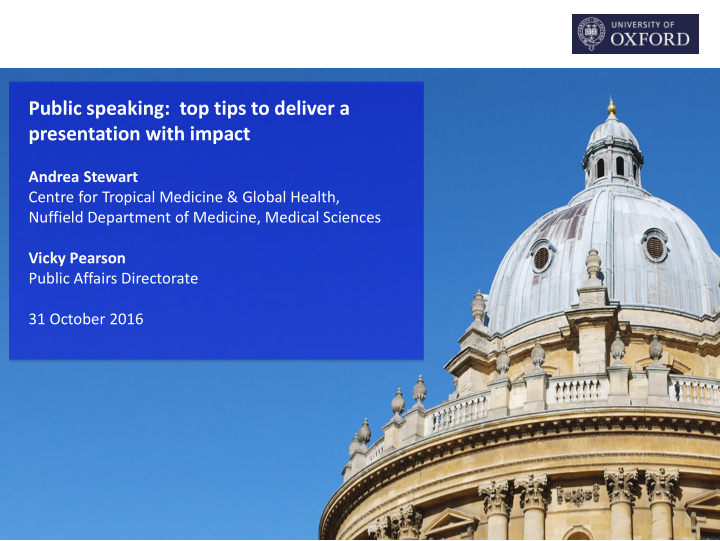



Public speaking: top tips to deliver a presentation with impact Andrea Stewart Centre for Tropical Medicine & Global Health, Nuffield Department of Medicine, Medical Sciences Vicky Pearson Public Affairs Directorate 31 October 2016
Did you feel cool, calm and collected?
Or stressed out?
Exercise: Remember one of your experiences of speaking in public. Think of two words or short phrases that describe what you remember about the it?
Why is that? Source: Washington Post
Exercise: Think of good and bad presentations you’ve seen. Talk with your neighbours about what worked, what didn’t and how you felt as an audience member.
A good example… https://www.ted.com/talks/sheryl_sandberg_why_we_have_too_few_women_leaders
Key ingredients • Keep it simple: short attention spans • Emotion: something personal / memorable e.g. funny, sad, surprising • Images – lots • Time keeping • Be positive
Prepare yourself • Plan: create a structure for your presentation: beginning, middle and end • Know your audience: who, age, expertise, languages … tailor • Include in your notes: SLOW DOWN or BREATHE • Practice your presentation: time yourself 1) Out loud on your own (record / video if possible) 2) In front of a friend / colleague
Body language • Smile and use hand gestures: engages your audience and releases those ‘happy’ hormones e.g. dopamine • Eye contact: look around • Move around : or sit down if it’s more appropriate
Power poses? Some research, like that co-authored by Amy Cuddy of the Harvard Business School (there’s a TED Talk if you’re interested) suggests that our posture actually affects how we feel – standing in so called ‘power poses’ for as little as two minutes, even if you don’t actually feel confident, can affect testosterone and cortisol levels in the blood and change how confident we feel. Cuddy suggests, for example, standing 2 minutes in a power pose before giving a presentation to help boost your confidence. Of course, in the cut throat world of academia, these conclusions have been questioned and one of the report’s original three authors Dana Carney has subsequently said the claims are nonsense! But there is absolutely no doubt that body language is a crucial part of communication.
Tips for keeping calm • Go for a walk: 10 minutes of fresh air to clear your head up to an hour beforehand • Visualise : somewhere calming • Deep ‘belly’ breaths: count 3,2,1 relax, relax, relax • Place a back-up question: in the audience
The golden rules Think about whether your Familiarise yourself with the Compose yourself attire suits the event room Don’t get stuck behind the Stick to time (and your Smile and enjoy yourself! lectern – move around timing)
What not to do! https://www.youtube.com/watch?v=rIABo0d9MVE
Things to avoid Death by PowerPoint! Including…. The occasional ‘um’ or ‘ er ’ is normal but too much gets distracting …or your slides Just reading from your notes…
“I’m not Barack Obama. I’m not Bill Clinton. Both of them carry themselves with a naturalness that is very appealing to audiences. But I’m married to one and I’ve worked for the other, so I know how hard they work at being natural. It’s not something they just dial in. They work and they practice what they’re going to say. It's not that they're trying to be somebody else. But it's hard work... to present yourself in the best possible way .”
Practice makes perfect… In groups of 4-6: * Each person in turn speak for 1 minute about their holiday. * After each speaker, take 1 minute to provide constructive feedback. * Agree 1 person to report back to the group on the 2 key things your group learned.
Dealing with the unexpected • Arrive early : make sure everything is working • Take a back-up of your slides and a hard copy of your presentation • Stay calm, explain what’s happening and get back on track • Don’t spend half your presentation trying to fix an IT problem – carry on and offer to share slides afterwards • If there are fewer people than expected, consider changing the room layout • Think about what you’d cut if others run over time or the session starts late • Have organiser contact details to hand in case you’re running late
https://www.youtube.com/watch?v=i1J_mxJotkI
Keep going – it gets better every time … • Find opportunities - personal & work • Ask for honest feedback: colleagues, friends, family • Watch TED talks www.ted.com
How can you share your knowledge? Spend 2 mins on your own: What opportunities could you find to practice your skills ? Can you think of ways to share your knowledge with other colleagues – support researchers, junior team members, even your boss?
Practice makes perfect… In groups of 4-6: * Each person in turn speak for 1 minute about how you got into comms. * After each speaker, take 1 minute to provide constructive feedback. * Agree 1 person to report back to the group on the 2 key things your group learned.
More help? • Books : Garr Reynolds: Presentation Zen Carmine Gallo: Talk Like TED . The 9 Public Speaking Secrets of the World's Top Minds • Courses: public speaking, presentation skills (OLI) • Coaching: private coach from £50 per hour
Please contact us with your questions Email: andrea.stewart@ndm.ox.ac.uk Telephone: 01865 857 412 Email: victoria.pearson@admin.ox.ac.uk Telephone: 01865 280 672
Recommend
More recommend